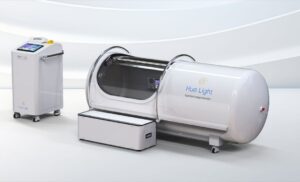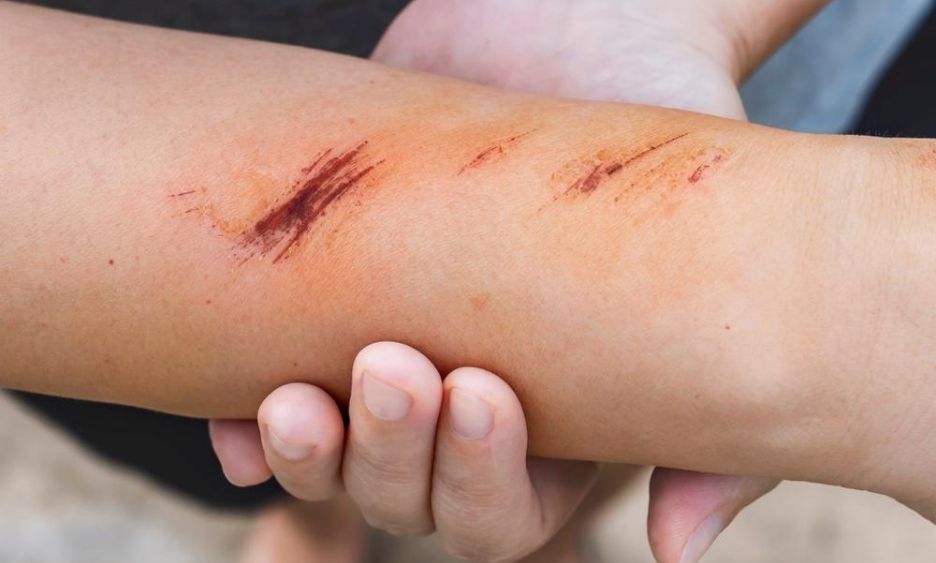Wound healing is a fundamental process that restores the integrity of skin and tissues after injury. While minor wounds generally heal naturally within days or weeks, chronic or complex wounds, such as diabetic foot ulcers, pressure sores, surgical wounds, diabetic wounds, or radiation injuries, often fail to heal properly, preventing wounds from healing properly. For such wounds, traditional treatment may not be enough, and patients can face prolonged recovery times, infections, or even the risk of amputation. Hyperbaric oxygen therapy is also used for conditions such as carbon monoxide poisoning and decompression sickness.
This is where hyperbaric oxygen therapy (HBOT) comes into play. Hyperbaric wound care has emerged as an advanced treatment approach that accelerates healing by increasing the oxygen available to damaged tissues. In a controlled clinical setting, patients breathe high-purity oxygen in a hyperbaric chamber, enhancing tissue regeneration and reducing complications. HBOT has a remarkable ability to enhance the body’s natural healing processes and improve patient outcomes.
In this comprehensive guide, we will explore what hyperbaric oxygen therapy for wound healing is, its mechanisms, types of wounds it treats, effectiveness, safety, and emerging home and clinical options.
What Is Hyperbaric Oxygen Therapy for Wound Healing?

Hyperbaric oxygen therapy (HBOT) is a medical treatment that involves breathing 100% oxygen in a pressurized environment. This environment is created inside a hyperbaric chamber, which can be either a monoplace chamber (for just one person, designed as a clear plastic tube that allows patients to relax and observe their surroundings) or a multiplace chamber (for multiple patients simultaneously).
Under normal air conditions, oxygen is carried by hemoglobin in the blood at normal air pressure. In a hyperbaric chamber, the air pressure is typically increased to 1.5–3 times higher than normal air pressure, which is much higher than normal air. This increased pressure allows oxygen to dissolve directly into the plasma. As a result, patients are completely immersed in extra oxygen due to the increased pressure, significantly boosting oxygen delivery to tissues that may have compromised blood flow due to injury, infection, or chronic conditions.
Hyperbaric wound care is widely recognized for its ability to enhance tissue repair, promote angiogenesis (formation of new blood vessels), and reduce infection risk. It is especially beneficial in patients with diabetic ulcers, radiation-induced wounds, burns, and chronic non-healing wounds.
How a Hyperbaric Chamber for Wound Healing Aids Recovery
The healing of complex wounds requires adequate oxygen, nutrient delivery, and the efficient removal of waste products. When circulation is impaired, traditional healing processes may slow down or even stall. A hyperbaric chamber for wound healing helps overcome these limitations by delivering oxygen at high pressures, resulting in several therapeutic benefits.
1. Enhanced Oxygen Delivery
Under normal conditions, oxygen is transported in the blood primarily by red blood cells. However, the increased pressure inside the hyperbaric chamber allows blood plasma to carry significantly more oxygen. This elevated oxygen delivery helps stimulate healing, especially in tissues with poor circulation.
2. Stimulation of Angiogenesis
Chronic or non-healing wounds often suffer from poor blood supply. HBOT stimulates angiogenesis, the formation of new capillaries, thereby improving blood flow and oxygen delivery to damaged tissues. This process is vital for long-term wound recovery and maintaining healthy tissue structure.
3. Reduction of Infection
High oxygen concentrations enhance the bactericidal activity of white blood cells, improving the body’s ability to fight infections. HBOT is especially beneficial for wounds complicated by bacterial growth, such as diabetic foot ulcers or radiation injuries. When combined with antibiotics, it accelerates infection control and reduces the risk of further complications.
4. Reduced Swelling and Inflammation
HBOT decreases tissue swelling and modulates inflammation by reducing oxidative stress and local edema. This not only relieves pain but also creates a more favorable environment for healing. By improving microcirculation and lowering inflammatory mediators, the therapy helps restore tissue balance.
Types of Wounds Treated with Hyperbaric Oxygen Therapy
Hyperbaric oxygen therapy is most effective for wounds that are slow to heal due to poor oxygenation or compromised circulation. In addition to these, HBOT is also used for treating patients with certain skin grafts and other complex wounds. Common wound types include:
1. Diabetic Foot Ulcers
Patients with diabetes often develop neuropathy and poor circulation, leading to chronic foot ulcers. HBOT improves oxygen supply to these wounds, accelerating healing and reducing the risk of infection or amputation.
2. Radiation-Induced Wounds
Radiation therapy can damage surrounding tissues, impairing blood supply and causing chronic ulcers. Hyperbaric treatment for wounds after radiation can restore tissue viability and promote repair.
3. Surgical and Traumatic Wounds
Some post-surgical wounds or injuries from trauma fail to heal properly due to tissue hypoxia. HBOT supports faster closure, reduces infection risk, and improves surgical outcomes.
4. Burns and Grafts
Partial and full-thickness burns, as well as skin grafts, benefit from hyperbaric wound care. By delivering oxygen directly to damaged tissues, HBOT supports graft integration and reduces complications.
The Hyperbaric Chamber: How It Works
A hyperbaric chamber is the central element of HBOT. Its design and function are crucial for ensuring safety and effectiveness. HBOT is commonly performed as an outpatient procedure, making it accessible and convenient for patients without the need for hospital admission.
Fire prevention protocols are strictly followed in the chamber, including avoiding items that could ignite or generate heat, such as lighters or battery-powered devices, to minimize fire hazards during the procedure.
Types of Hyperbaric Chambers
- Monoplace Chambers: Designed for a single patient, these chambers are pressurized with pure oxygen and provide full-body exposure.
- Multiplace Chambers: Accommodate multiple patients, where oxygen is delivered via masks or hoods while the chamber is pressurized with air.
Typical HBOT Session
- Sessions usually last 60–120 minutes, with patients seated or lying down comfortably.
- Pressures typically range from 1.5 to 3.0 atmospheres absolute (ATA).
- Treatment frequency may vary from daily sessions to multiple times per week, depending on the wound type and severity.
Safety Protocols
- Patients are closely monitored for ear barotrauma, sinus discomfort, or oxygen toxicity.
- Staff ensure gradual pressurization and decompression to prevent complications.
How Many Sessions Are Needed for Wound Healing?
The number of hyperbaric oxygen therapy sessions required for optimal wound healing depends on several factors, including the type and severity of the wound, your overall health, and how your body responds to therapy. For chronic wounds such as diabetic foot ulcers or other non-healing wounds, patients often need a series of hyperbaric oxygen therapy sessions to achieve complete healing.
Typically, a treatment plan may involve anywhere from 20 to 40 hyperbaric oxygen therapy sessions, with each session lasting between one and two hours. Your healthcare provider will closely monitor your progress and adjust the number of sessions as needed to support the healing process. The primary goal of these sessions is to deliver more oxygen to the affected tissues, stimulate the growth of new blood vessels, and enhance the body’s natural ability to repair itself.
By following the recommended course of oxygen therapy, patients with chronic wounds can experience significant improvements in wound healing, reduced risk of complications, and a better overall quality of life. Always consult with your healthcare provider to determine the most appropriate treatment plan for your specific medical condition.
Hyperbaric Wound Care Process
The clinical process for HBOT involves careful planning and multidisciplinary coordination. Healthcare providers regularly assess, measure, and document the wound to monitor how the wound responds to therapy, which helps guide treatment adjustments and track progress.
1. Assessment and Consultation
A wound care specialist evaluates the wound, considers underlying medical conditions, and determines HBOT suitability. Imaging or blood tests may be conducted to assess tissue oxygenation.
2. Treatment Planning
The treatment schedule, pressure settings, and session duration are customized based on wound type, size, and severity. Patients are instructed on pre- and post-treatment care.
3. Monitoring and Progress
During HBOT, the wound’s healing progress is tracked through clinical evaluation, photographs, and oxygen measurements. Adjustments are made to optimize results.
4. Integration with Other Therapies
HBOT is often used alongside standard wound care, including debridement, dressings, antibiotics, and lifestyle modifications such as blood sugar control in diabetic patients.
Benefits of Hyperbaric Oxygen Therapy for Wound Healing

The advantages of HBOT are well-documented in both clinical research and patient outcomes:
- Accelerated Healing: HBOT provides oxygen at concentrations significantly higher than normal, enabling faster tissue regeneration. This process, often referred to as hyperbaric healing, provides long-term benefits for chronic and non-healing wounds.
- Reduced Infection Risk: High oxygen levels improve immune function and support antibiotic therapy.
- Improved Surgical Outcomes: For post-surgical wounds and grafts, HBOT enhances tissue survival and integration.
- Enhanced Quality of Life: Patients experience less pain, fewer complications, and faster return to daily activities.
Related Article: Benefits Of Hyperbaric Oxygen Therapy
Effectiveness and Scientific Evidence
Numerous studies confirm the efficacy of hyperbaric oxygen for wound healing:
- Diabetic Foot Wound: The American Diabetes Association shows that HBOT improves healing rates, reduces amputation risk, and accelerates recovery.
- Radiation Injuries: Patients receiving HBOT demonstrate better tissue repair and reduced necrosis. Cochrane Review
- Chronic Non-Healing Wounds: Wiley indicates that HBOT stimulates angiogenesis, reduces edema, and promotes wound closure.
Wound care and hyperbaric medicine together represent an evolving field focused on restoring tissue health through advanced oxygen-based treatments. Many specialized centers offer hyperbaric oxygen therapy for wound healing, emphasizing its high success rate and patient satisfaction. Patients should receive treatment at reputable, certified facilities to ensure safety and optimal results.
While HBOT is highly effective for certain conditions, it is not suitable for all wounds. Contraindications include untreated pneumothorax, certain respiratory disorders, or uncontrolled seizures. Therefore, individual evaluation by a qualified healthcare professional is essential.
Risks, Side Effects, and Safety Considerations
Like all medical treatments, HBOT carries some risks:
- Ear and Sinus Pressure: Changes in atmospheric pressure can cause discomfort or barotrauma. Some patients may experience mild discomfort, such as ear popping, during pressurization.
- Pressure Related Injury: There is a potential for pressure-related injury, particularly affecting the ears or nose, especially in individuals with certain medical histories.
- Fatigue or Dizziness: Some patients experience mild tiredness post-session.
- Oxygen Toxicity: Rare, but high oxygen concentrations can affect the lungs or nervous system.
- Fire Hazard: Strict protocols are enforced due to high oxygen levels.
Hyperbaric oxygen therapy is safe when administered by trained professionals in accredited facilities, with strict safety protocols and proper monitoring practices in place. Overall, HBOT is safe when administered under professional supervision, with adverse events being uncommon.
Hue Light Hyperbaric Oxygen Chamber
For patients seeking advanced hyperbaric treatment, the Hue Light HBOT chamber offers a safe, efficient, and comfortable solution. The chamber is specifically designed to deliver HBO therapy efficiently and comfortably, ensuring patients receive the full benefits of hyperbaric oxygen therapy. Designed for both clinical and home use, it provides controlled pressurized oxygen therapy in a user-friendly environment. Patients benefit from enhanced wound healing, improved oxygen delivery, and safe protocols verified by medical professionals. Hue Light chambers are particularly suitable for chronic wound management, diabetic ulcers, post-surgical recovery, and rehabilitation support.
Final Thoughts on the Hyperbaric Chamber for Wound Healing
Hyperbaric oxygen therapy for wound healing represents a significant advancement in modern medicine. By delivering high-pressure oxygen directly to compromised tissues, HBOT accelerates wound closure, reduces infection, supports graft survival, and improves overall recovery outcomes.
Whether used for diabetic foot ulcers, radiation injuries, chronic non-healing wounds, or surgical recovery, HBOT offers a scientifically validated approach to hyperbaric wound care. Patients considering HBOT should consult with qualified wound care specialists or hyperbaric medicine physicians to determine suitability and create a personalized treatment plan.
With innovations like the Hue Light HBOT chamber, hyperbaric therapy is becoming more accessible, safe, and effective, helping patients achieve faster healing and improved quality of life.
References:
- Hyperbaric Oxygen Therapy for Diabetic Foot Wounds. (2010). PMC.
- The use of hyperbaric oxygen therapy to treat chronic wounds: A review. (2008).
- Hyperbaric oxygen therapy for nonhealing wounds: Treatment outcomes and angiogenesis evaluation. (2020). PMC.
- Antioxidant response of chronic wounds to hyperbaric oxygen therapy. (2016).












